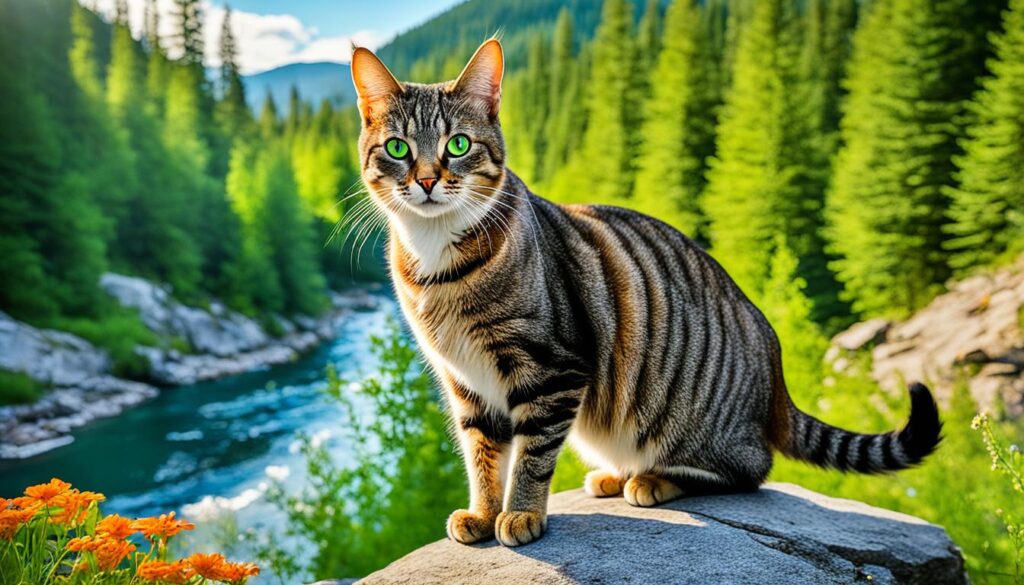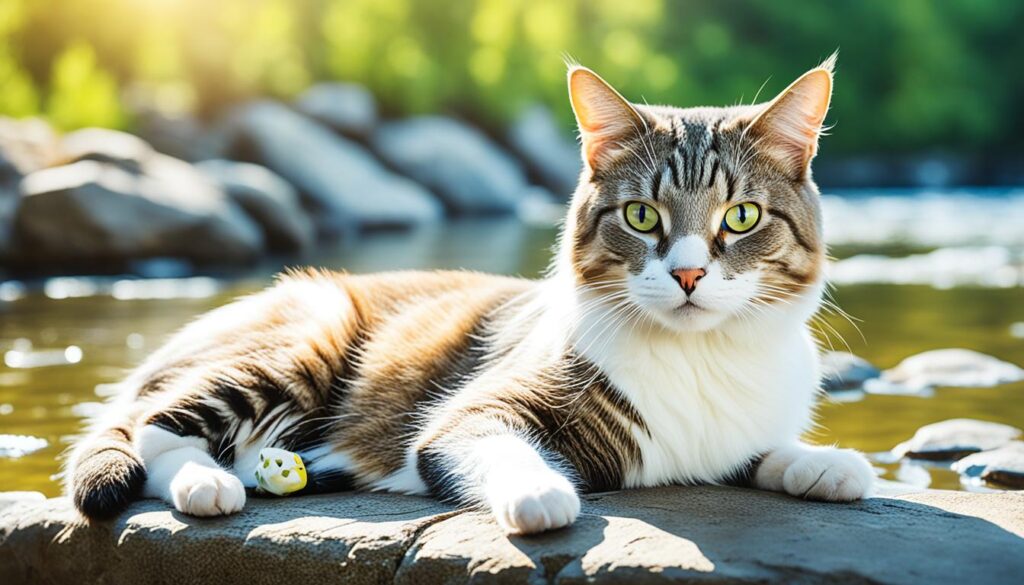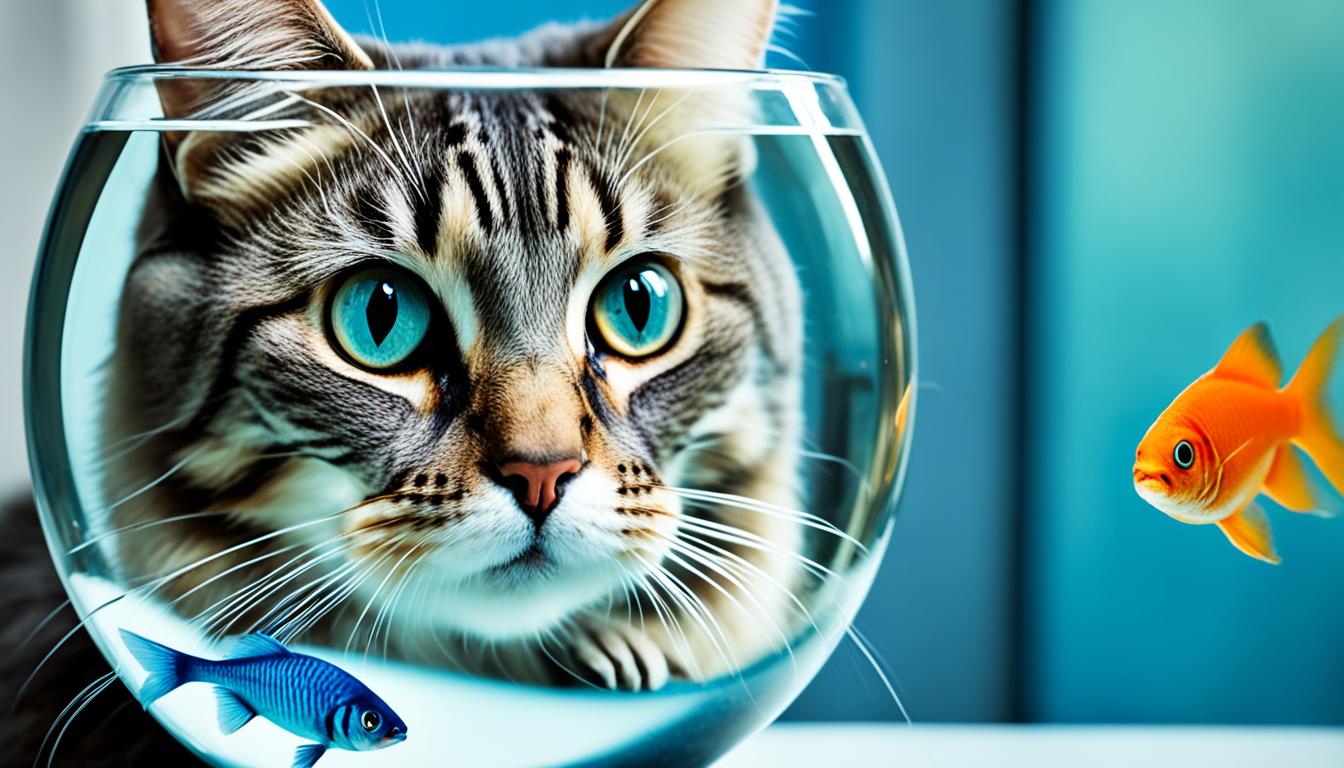As an Amazon Associate I earn from qualifying purchases.
Ever noticed the way your cat’s ears perk up at the crinkle of a fish food bag? Or the focused intensity in their gaze as they zero in on a fishbowl? There’s a compelling allure that fish seems to hold over our feline companions, an attraction that transcends the simple act of eating. Beyond the bowl of your pet, this phenomenon has deep roots, diving into the ancestral behaviors of cats. In seeking to understand why do cats like to eat fish, we not only feed our curiosity but also nourish a deeper bond with these mysterious creatures.
Fish, as part of a cat’s diet and fish consumption, has been a consistent fixture throughout history. Ancient felines roamed the edges of water bodies, their diets enriched by the bountiful source of protein before them. Today, this fascination with seafood endures, cultivated and catered to by the myriad of options lining pet store shelves. But what is it about fish that makes it such a staple in feline diet choices? Join us as we scale the tales and truths of this fishy fascination, a journey that might reveal as much about ourselves as it does about our cat’s preferences.
Key Takeaways
- Exploring the historical relationship between cats and their predilection for fish.
- Understanding cultural and anecdotal observations of cats’ diet and fish consumption.
- Diving into the sensory and behavioral factors that explain why cats like to eat fish.
- Considering the role of fish in both wild and domestic feline diet choices.
- Introducing the main themes of cat nutrition and the pervasive place of fish within it.
Exploring Feline Diet Choices Through the Ages
As a pet lover, you might have noticed your cat’s insatiable longing for seafood. This isn’t merely a modern preference; the roots of feline seafood cravings trace far back. In ancient times, cats were lauded for their ability to control pests, but they also had access to natural water sources teeming with fish, making fish in cat nutrition an essential element from early on. The dietary habits formed by their wild ancestors have influenced feline diet choices to this present day.
During the Egyptian era, cats were often depicted in art and scripture, hinting at a societal reverence that might have led to better feeding opportunities, which included fish. Moving into medieval Europe, cats often fended for themselves, but those residing near ports or rivers would have undoubtedly capitalized on the abundance of fish. The relationship between humans and cats evolved, leading to the domestication that saw cats brought indoors and fed kitchen scraps – often including fish.
By the 19th century, commercial pet food was a rising trend, and by the early 20th century, canned cat foods often highlighted fish flavors to cater to feline seafood cravings. The table below illustrates the various fish types incorporated into cat food over the years, signaling how feline diet choices have transitioned through eras:
| Time Period | Fish Types in Cat Food | Impact on Feline Nutrition |
|---|---|---|
| Ancient Civilizations | Local Freshwater Fish | Direct source of protein and nutrients |
| Medieval Period | Portside Catch of the Day | Supplementary diet for free-roaming cats |
| Early 20th Century | Canned Mackerel, Tuna, Sardines | Introduction to commercial cat food with fish as a main ingredient |
| Modern Day | Variety including farm-raised and wild-caught options | Balanced and specialized diets accommodating diverse feline needs |
Today’s pet food manufacturers take into account both the historical and nutritional aspects of cats’ affinity for fish, offering myriad choices satisfying both their nature and our desire to provide them with the best. Whether it’s wet food or kibble, the presence of fish remains strong, proving that the journey of feline diet choices is not only about sustenance, but about a bond that has enriched both feline lives and human understanding through the centuries.
The discussion of cat diets is no longer just about satiating hunger; it has become a fascinating exploration into the health and wellness of our beloved pets. From the catch of the ancient rivers to the modern bowls of our homes, fish in cat nutrition remains a topic that encapsulates the affection we harbor for our furry companions and the depths we’ll explore to keep them thriving.
The Irresistible Aroma: Understanding Cat Food Preferences
Have you ever noticed how your feline friend perks up at the whiff of seafood? It’s no secret that cats have a special fondness for fish, but what exactly about it captivates their senses and drives their dietary preferences? Let’s dive into the sensory world of cats and uncover why fish in cat nutrition is so alluring.
The Scent of the Sea: Fish and Feline Sensory Attraction
Cats are renowned for their exceptional olfactory capabilities, and nothing seems to entice them quite like the aroma of fish. Whether fresh or cooked, the scent of the sea inherent in seafood can stimulate a cat’s sense of smell, playing a notable role in their cat food preferences. This scent triggers a primal response, linking back to their ancestral hunting days.
Taste Buds and Texture: What Appeals to Cats in Fish
Fish not only appeals to the keen nose of a cat but also to their discerning taste buds. The distinct texture of seafood, often soft and easy to break apart, is something cats usually find highly palatable. The flavors released upon consumption satisfy their feline seafood cravings and often result in fish being a favorite among various cat food options.
| Attribute | Appeal to Cats |
|---|---|
| Olfactory Stimulation | Strong fishy scent activates the keen sense of smell. |
| Flavor Profile | Unique umami and savory tastes attract feline taste buds. |
| Texture | Typically moist and flaky, easy for cats to consume. |
| Nutritional Content | High in protein and omega-3 fatty acids beneficial for health. |
Understanding these sensory attractions gives us insight into cat food preferences and the ubiquity of fish in cat nutrition. It’s a combination of natural inclination and sensory satisfaction that keeps our cats coming back for more of the flavors of the ocean.
Behavior of Cats Towards Fish: More Than Just Food
When you observe a cat in the presence of fish, you’re witnessing a complex interplay of instincts and behaviors that goes far beyond basic sustenance. Cats are known for their skilled hunting and particular cat food preferences, but their behavior towards fish reveals a much deeper biological script. Let’s dive into the ways felines interact with their aquatic counterparts.
The Hunting Instinct: Exploring the Feline Predatory Drive
Your cat’s ancestors hunted to survive, and though today’s domestic felines are far removed from those wild origins, the instinctual drive remains powerful. Fish, with their swift movements and shiny scales, evoke a cat’s predatory behavior. They stimulate a cat’s inherent urge to stalk and capture their prey, which explains some of the intense fascination cats have with fish. This predatory behavior is not merely for survival; it’s embedded in their DNA as a deeply ingrained instinct.
Playful Predators: Why Cats Interact With Fish as Prey
It’s not all about the hunt; there’s also an element of play when cats interact with fish. Prior to pouncing, cats may bat at their prey, toss it into the air, or play a captivating game of ‘cat and fish’. This interaction is part of their complex behavior, ensuring they remain agile and engaged. Fish not only serve as a viable component in feline diet choices, but they are also essential in keeping a cat’s hunting skills sharp and their reflexes quick.
Below is an overview of common behaviors exhibited by cats when encountering fish, highlighting their dual roles in a cat’s life:
| Behavior | Role in Diet | Role in Instinct |
|---|---|---|
| Stalking | Assessment of potential food source | Exercise of stealth and patience |
| Pouncing | Physically capturing nutrition | Release of pent-up energy and reflex testing |
| Playing | N/A | Development of cognitive skills and stimulation |
As you can see, fish are far more than just a dietary staple in the world of cats – they are an integral part of their being, providing both physical nourishment and mental stimulation. Whether it’s the natural allure of fish that influences cat food preferences or the inherent pleasure a cat finds in the act of hunting, fish hold a unique place in the hearts and habits of our feline friends.
Why do cats like to eat Fish: Breaking Down the Facts
As we delve into the reasons behind feline preferences for fish, it’s essential to understand the deep-rooted connection between cats’ evolutionary history and their modern-day cravings. It’s not just about the savory taste; it’s about how fish as a food source integrates with their biological needs. Let’s explore the compelling reasons why our feline friends are naturally drawn to the flavors of the sea.

Evolutionary Diet: How Nature Dictates Feline Cravings
The wild ancestors of domestic cats were skilled hunters, relying on a protein-rich diet for survival. With evolution, these inherent traits have been passed down to contemporary cats. The nutritional profile of fish, packed with essential proteins and amino acids, closely mirrors the sustenance wild cats would hunt for themselves. This historical success in nourishing their bodies has etched an instinctive preference for fish in our domestic cats’ palates.
Fish as a Natural Cat Protein Source: Nutritional Benefits
Fish is more than just a tasty treat for cats; it offers a wealth of health benefits that support their well-being. As a high-quality protein source, it plays a crucial role in muscle development and maintenance. Moreover, fish provides a natural abundance of omega-3 fatty acids, aiding in cognitive function and reducing inflammatory diseases. It’s a perfect marriage of flavor and function that satisfies both feline taste buds and dietary needs.
| Nutrient | Benefits for Cats | Common Fish Sources |
|---|---|---|
| Protein | Essential for growth, muscle maintenance, and repair | Salmon, tuna, sardines |
| Omega-3 Fatty Acids | Improves coat health, aids in joint mobility, supports cognitive functions | Mackerel, trout, herring |
| Amino Acids | Crucial for metabolic processes and overall bodily functions | Whitefish, cod, flounder |
| Vitamins & Minerals | Promotes immune health, bone strength, and organ function | Various fortified fish-based cat foods |
As you consider incorporating fish into your cat’s diet, remember that while it offers multiple benefits, balance is key to ensuring their health. While fish can be an excellent protein source, it should complement a varied and nutritious diet suitable for your cat’s needs. Understanding why cats like to eat fish shines a light not only on their gastronomic preferences but also on their nutritional necessities.
Popular Cat Food Flavors: Why Fish Tops the Chart
As you stroll through the pet food aisle, you’ll likely notice that popular cat food flavors seem to be dominated by fish. This isn’t just a serendipitous trend; it’s the outcome of meticulous market research and consumer behavior analysis. Cats have discerning cat food preferences, and it turns out that fish flavors often tantalize their taste buds the most. But why is this the case? Let’s dive into the world of feline diet choices to understand why products like salmon, tuna, and ocean whitefish stand out in the crowded pet food marketplace.
Market Demand and Popular Choices
Understanding feline preferences involves more than just observing your pet; it reflects a broader pattern seen across countless households. The demand for fish-flavored cat foods is not only a testament to the flavors cats love but also indicates owners’ desire to provide a diet that mimics natural feline prey. Here is a table that breaks down some of the most sought-after fish flavors in the cat food market:
| Fish Flavor | Consumer Rating | Noted Benefits |
|---|---|---|
| Salmon | 4.8/5 | Rich in Omega-3 and essential oils for a shiny coat |
| Tuna | 4.7/5 | High protein content for lean muscle development |
| Ocean Whitefish | 4.6/5 | Milder flavor preferred by finicky eaters |
| Mackerel | 4.5/5 | Dense nutrients to support overall health |
| Trout | 4.5/5 | Distinctive taste that appeals to adventurous felines |
However, it’s not just about the fish itself; the way these flavors are incorporated into cat food products also matters. Modern manufacturing techniques allow for fish flavors to be distributed consistently throughout the food, making every bite equally appetizing for your cat.
Marketing’s Role in Flavor Popularity
It’s important to acknowledge how marketing has played a pivotal role in solidifying the reputation of fish flavors. Through attractive branding and targeted advertising, companies have successfully positioned fish as a premium, health-forward option in the realm of cat food preferences. Traditionally associated with luxury and high cuisine, including fish in your cat’s diet is often seen as providing the best nature has to offer.
In essence, when selecting your cat’s next meal, you’re likely influenced both by what you believe will foster health and vitality and by what appeals to your cat’s innate preferences. Feline diet choices are heavily swayed by these factors, and as the data shows, fish flavors hold a unique position at the convergence of these considerations, continually leading the charts.
Benefits of Fish for Cats: A Nutritional Perspective
As a cat owner invested in the wellbeing of your feline friend, you may often ponder the benefits of fish for cats. It’s well-known that fish is a beneficial component of a feline diet, but the specific advantages warrant a closer look, particularly when it comes to Omega-3 and fatty acids. These nutrients play a crucial role in maintaining your cat’s health, from supporting their immune system to ensuring the luster of their coat.

Omega-3 and Fatty Acids: Boosting Feline Health with Fish
Why are omega-3 and fatty acids so significant for your cat’s diet? These elements are essential for reducing inflammation, aiding in the proper development of the brain and eyes, and promoting heart health. Regular consumption of fish rich in these nutrients can contribute to your cat’s longevity and vitality. These positive effects extend to external aspects too, like a shiny coat and healthy skin, which can be directly liked to the inclusion of omega-3 and fatty acids in their meals.
Balancing the Meal: When Fish Should Be Part of a Cat’s Diet
While the nutritional benefits of fish are impressive, balance is key in feline diet choices. Including fish as a part of your cat’s varied diet works wonders, but it should complement a broad range of vitamins and minerals from other food sources. Understanding how to integrate fish into your cat’s meal plan without overdoing it is essential. The general consensus among veterinarians suggests that fish should be a supplemental rather than a primary food, ensuring that your cat enjoys a rounded and complete diet for optimal health.
Fish in Cat Nutrition: Debunking Myths
When it comes to satisfying your feline’s seafood cravings, it’s essential to weigh the benefits against potential risks to make informed choices about your cat’s diet. Let’s dive into some of the prevailing myths and provide clarity on fish in cat nutrition.
Mercury Concerns and Safe Fish Options for Cats
One of the main concerns pet owners have is mercury exposure through fish consumption. The truth is, not all fish pose the same risk. Mercury levels can vary widely, so it’s critical to choose seafood that is low in mercury for your cat’s meals. Here are some of the safer options that you can consider:
- Salmon – Low in mercury and high in Omega-3 fatty acids.
- Tilapia – A generally safe choice with lower mercury levels.
- Canned light tuna – Often safer than albacore or white tuna, but it should be given in moderation.
- Catfish – Usually farm-raised, which tends to have lower mercury levels.
Now, let’s look at portion control and ensure that you’re giving just the right amount.
Understanding the Right Portion: How Much Fish is Healthy?
The key to incorporating fish into your cat’s diet isn’t just about choosing low-mercury fish; it’s also about quantity. Knowing the right portion can help you harness the benefits of fish while minimizing any dangers. Here’s a quick guide:
| Fish Type | Recommended Portion | Frequency |
|---|---|---|
| Salmon | 1-2 ounces | Twice a week |
| Tilapia | 1-2 ounces | Once a week |
| Canned light tuna | 1 ounce | Once a week |
| Catfish | 1-2 ounces | Twice a week |
Feeding your kitty the proper amount of fish not only satisfies their cat food preferences but also contributes positively to their overall nutrition. Remember, variety is the spice of life, even for your cat—so ensuring a balanced diet, along with these safe and portion-controlled fish delicacies, is essential for their health and happiness.
Conclusion
Your journey through the fascinating world of cat diet and fish consumption has unveiled numerous layers behind the quintessential image of a cat happily munching on fish. As we’ve discovered, the benefits of fish for cats are manifold, ranging from the rich tapestry of sensory experiences to the wholesome nutritional value that fish provides. The historical significance of fish in feline diets has evolved alongside domestication, reinforcing the natural predilection cats possess for this type of food.
The behavior of cats towards fish is not limited to simple dietary preference. It embodies an instinctive connection between predator and prey, a deeply ingrained part of their ancestry that compels them to engage with fish in complex and sometimes playful ways. Yet beyond instinct, fish offers a bounty of health advantages like omega-3 fatty acids, crucial for maintaining a shiny coat and supporting overall health.
As we close this insightful exploration, remember that while fish can play a pivotal role in a cat’s diet, balance is essential. A diverse diet ensures your feline friend receives all the nutrients needed to thrive. Armed with this knowledge, you now can understand and appreciate why fish is more than just a treat; it’s a healthful inclusion in your cat’s diet that supports vitality and satisfaction.
FAQ
Why do cats like to eat fish?
How have feline diet choices evolved through the ages?
How do the scent and taste of fish appeal to cats?
Why do cats interact with fish both as food and as prey?
What are the benefits of fish for cats?
Why is fish a common flavor in popular cat food?
Why is it important to balance fish with other foods in a cat’s diet?
What are safe fish options for cats, considering mercury concerns?
How much fish is healthy for a cat’s diet?
Catching Fish to Feed Your Cat Take Me Fishing Travel
As an Amazon Associate I earn from qualifying purchases.


[…] Unraveling the Mystery: Why Do Cats Like to Eat Fish Catnip Meow Hub […]